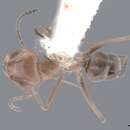en
names in breadcrumbs


Extant: 8 valid subspecies
Prenolepis pyramica Roger, 1863a PDF: 160 (w.) BRAZIL. Neotropic. AntCat AntWiki HOLTaxonomic history
Emery, 1888c PDF: 362 (m.); Gallardo, 1916b PDF: 56 (q.); Wheeler & Wheeler, 1951 PDF: 183 (l.); Goñi et al., 1984 PDF: 366 (k.).Combination in Dorymyrmex: Mayr, 1870b PDF: 947.Combination in Dorymyrmex (Conomyrma): Forel, 1913m PDF: 244.Combination in Conomyrma: Kusnezov, 1952j PDF: 430.Combination in Dorymyrmex: Shattuck, 1992c PDF: 85.See also: Emery, 1895d PDF: 331; Snelling, 1973b PDF: 4; Cuezzo & Guerrero, 2012 10.1155/2012/516058 PDF: 19.Literature records: “Paraguay” (s. loc.) (Kempf 1972).
Record may refer to D. paranensis . See discussion under D. paranensis below.
(No. 52 a a 52 e). [[ worker ]] et [[ male ]].
(52). Pretty common on the windward side, and near the southern end of the island; above the seashore, or on slopes near it. Rarely on the leeward side. The formicarium is generally in sandy soil, where the sand is supported by roots of grass, & c. It is without shelter, opening on the surface of the ground ' by a small perpendicular tunnel; about this there is generally a small mound of loose sand, & c, not over an inch high, and four inches in diameter. The nest proper is about a foot below the surface, and probably goes deeper, as I have not yet obtained the female; it appears to consist of a few passages, not more than half an inch in diameter, horizontal, or nearly so, and without larger chambers. In these passages I have found larvae and males with the workers. The communities apparently are small, having, one or two hundred workers; but several tunnels are generally found near each other, and these may belong to a common, larger, and deeper nest. The workers and males are active; the latter do not fly when the nest is opened, so far as I have observed. Workers are sometimes found on bushes near the seashore.
(52 a). Near Brighton Estate (southern end of the island). Nov. 17 th. Dry hill-sides, below 300 ft., overlooking flats by the sea; in roads, scrubby growth, rather hard ground; at the mouths of perpendicular tunnels..
(52 b). Not noted; apparently an immature specimen of this species.
(52 c). Leeward; seashore thickets at Wallibou. Oct. 8 th. Beaten from bushes.
(52 d). Windward; seashore, at back of the open sands; Grand Sable Estate. Jan. 3 rd. From two nests in sandy ground, supported by roots.
(52 e). Sandy, open valley of the Dry River; windward, near the sea. Jan. 2 nd. From several nests, as described above.
[[ worker ]] Surubres pres San Mateo, plage Pacifique, Costa Rica (Biolley).
Dorymyrmex pyramicus is a species of ant in the genus Dorymyrmex. Described by Roger in 1863, the species is found in many countries of South America.[1]
Dorymyrmex pyramicus is a species of ant in the genus Dorymyrmex. Described by Roger in 1863, the species is found in many countries of South America.